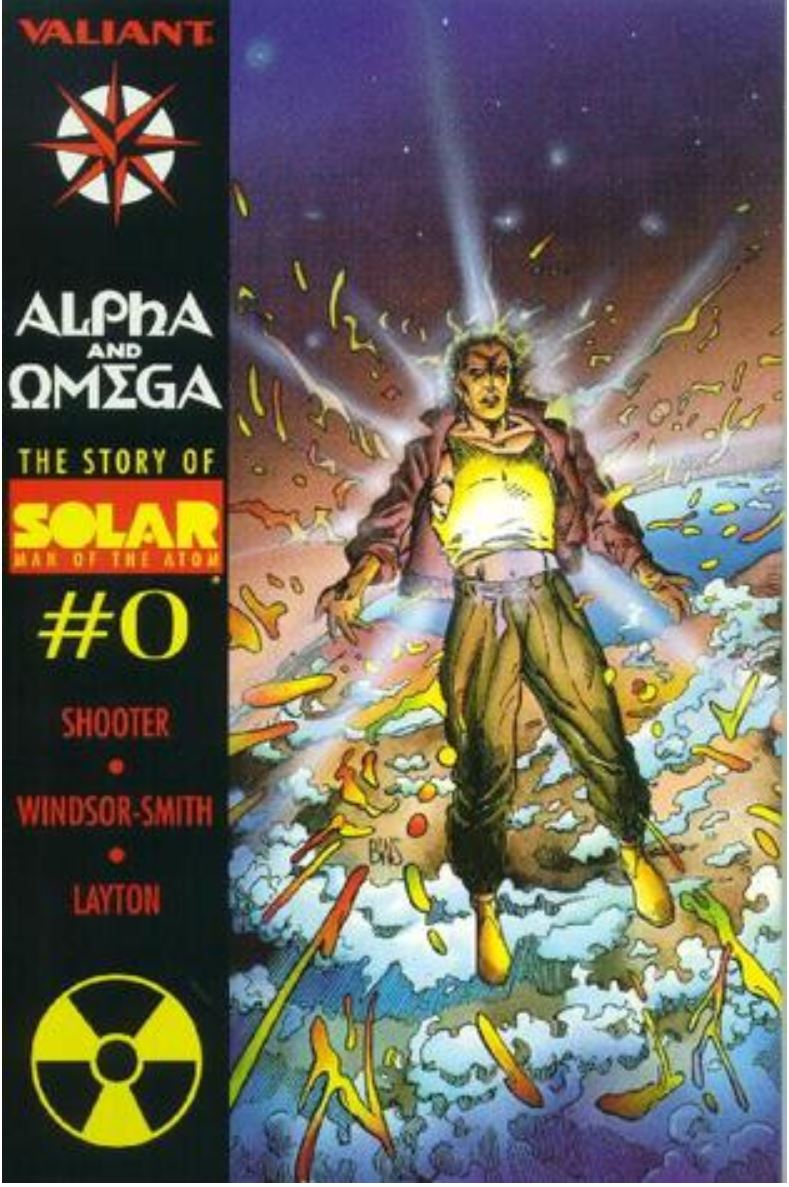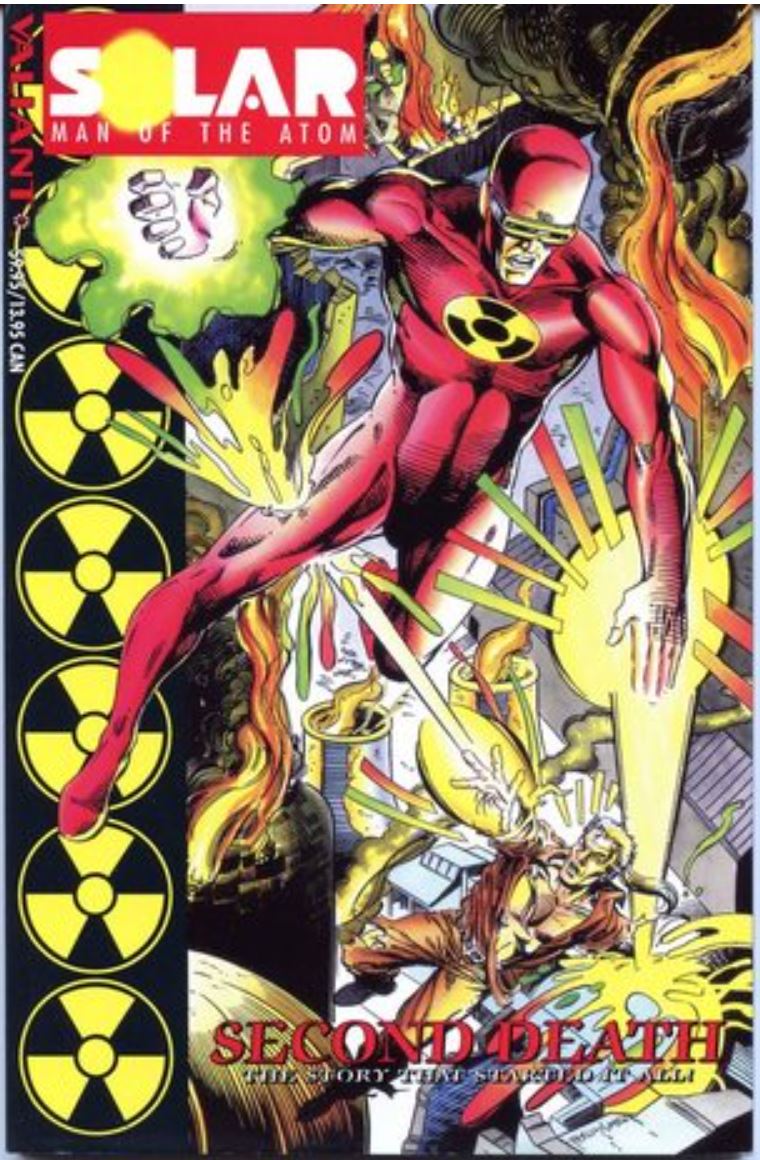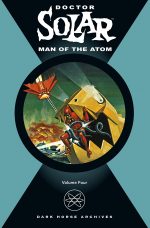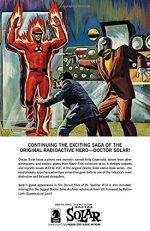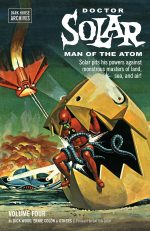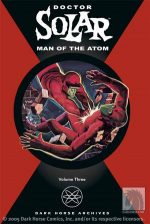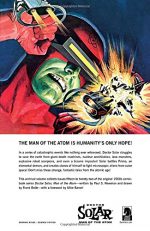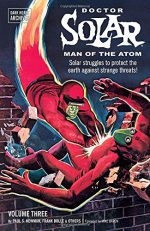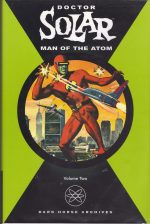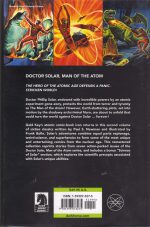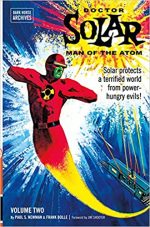Word came yesterday that we’ve lost yet another comics giant. James Charles Shooter (27th September 27th 1951 – 30th June 2025) wrote countless comics stories, from the minor to the most major of major stars, and changed or steered the courses of US comic book stars with landmark tales like Marvel Super Hero Secret Wars, Secret Wars 2, Avengers: The Korvac Saga, The Superman vs. Flash race tradition, and Original Graphic Novels for Dazzler, Thor, the Avengers & X-Men (The Aladdin Effect) and more.
Wikipedia has a very fair assessment of him which you can read here .
Jim Shooter began his creative career at DC, a teenager helping his poorly-paid parents with bills. His submissions impressed editor Murray Boltinoff who bought his early stories, leading to residencies on the Legion of Super-Heroes and most of the Superman family of titles.
Combining his continued education with the stresses of being a jobbing writer, when he moved to Marvel his tales included continuity-changing runs on Daredevil, The Avengers, Super-Villain Team-Up, Ghost Rider, Spider-Man and others. As editor and publisher he created child-friendly imprint Star Comics for younger readers, sanctioned creator-owned venue Epic Comics and created Marvel’s New Universe sub-strand (writing core title Star Brand – some would say as autobiographical wish fulfilment). He pushed moving beyond the company’s established complex-continuity roots, writing “real world” material such as Team America and others. He also forged indelible links with toy and licensing brands that swiftly made Marvel the most profitable comics publisher in the US.
Outspoken, controversial and often ferociously dogmatic, Jim was Business to the bone without ever forgetting his blue-collar, poverty-driven roots. Bluntly, he alienated many key creators, but whatever others thought, did what he considered best. However, his work – he also pencilled many stories – was never dull and never, never, never boring. He was a master of science fiction themes, and understood childlike wonder, loss and comedy moments.
Always championing creator rights, Jim instituted return of artwork to artists and, when ousted from Marvel and setting up his later companies Valiant, Defiant and Broadway Comics, operated a collective writing policy that saw every participant in the incredibly collaborative process of making comics fully credited and remunerated for their contributions. He also always mentored new talent and encouraged everyone to push their own limits.
Jim Shooter was One of Us: a comics fan and story lover who made the jump from consumer to creator, so I’m asking those who care to remember him for his less well known – but often best written – efforts by hunting down and enjoying the items – or any Shooter effort – reviewed here.

The Valiant Era Collection and Warriors of Plasm
By Jim Shooter, Bob Hall, Faye Perozich, Kevin Vanhook, Don Perlin, Steve Ditko, Gonzalo Mayo, Stan Drake, Yvel Guichet, Ted Halsted, John Dixon, Paul Autio & various (Valiant)
No ISBN/ ASIN: B000H2UTEI
During the market-led, gimmick-crazed frenzy of the 1990s, amongst the interminable spin-offs, fads and shiny multiple-cover events a new comics company revived some old characters and proved once more that good story-telling never goes out of fashion. At DC, 14-year-old Shooter wrote epic runs on The Legion of Super-Heroes, Supergirl and Superman, and scripted the company’s first toy tie-in Captain Action, before moving to Marvel in 1976. When he became the Editor-in-Chief, Shooter made Marvel the most profitable and high-profile they had ever been. and, after his departure, used that writing skill and business acumen to transform an almost forgotten Silver-Age character pantheon into contemporary gold.
Western Publishing had been a major player since comics’ earliest days, blending a wealth of licensed titles such as TV and Disney titles, Tarzan, and the Lone Ranger with homegrown hits like Turok, Son of Stone and Space Family Robinson. During the 1960s superhero boom, these adventure titles expanded to include, Brain Boy, M.A.R.S. Patrol – Total War, Magnus, Robot Fighter and in deference to the atomic age of heroes, Nukla and the utterly brilliant Dr. Solar, Man of the Atom. Despite supremely high quality and passionate fan-bases, they never captured the media spotlight of DC or Marvel’s costumed cut-ups. Western shut up their comics division in 1984.
With an agreement to revive some, any or all of these four-colour veterans, Shooter and co-conspirator Bob Layton came to a bold decision and made those earlier adventures part-&-parcel of their refit: acutely aware that older fans don’t like having their childhood favourites bastardized and that revivals need all the support they can get. Thus the old days were canonical: they “happened”…
The company launched with a classy reinterpretation of science fiction icon Magnus, but the key title to the new universe they were building was the broadly super-heroic Solar, Man of the Atom Alpha & Omega and Second Death which launched with an eye to all the gimmicks of the era, but also cleverly realised and realistically drawn.
Hit after hit followed and the roster of heroes expanded until dire market conditions and corporate chicanery ended the company’s stellar expansion. Gradually it fractionated and despite many revivals since, has all but disappeared now…
Here’s another innovation of that idea-packed era – a sampler of hits and one of their earliest graphic novels – from the early days of the format we’re all so familiar with. The Valiant Era Collection, re-presenting Magnus #12, Solar #10-11, Eternal Warrior #4-5 and Shadowman #8 was released in 1994 as an introduction to the new old brand and canny compendium of first appearances from the company’s burgeoning continuity. It gathered a disparate selection of tales which had one thing in common: the debuts of characters that had quickly become “hot”.
In the collector-led era of the early 1990s – before one zillion internet sites and social networking media – many new concepts caught the public’s attention only after publication. The seemingly-savvy snapped up multiple copies of comics they subsequently couldn’t sell and many genuinely popular innovations slipped by unnoticed until too late. This trade paperback from a company that valued storytelling above all else addressed that thorny issue by simply bundling their own hot and hard to find hits in one book…
‘Stone and Steel’ was written by Faye Perozich & Shooter and illustrated by Gonzalo Mayo, and found Robot-Fighting superman Magnus transported to a timeless dimension where dinosaurs and cavemen existed side by side. Once there he became embroiled in a battle for survival against his old enemy Laslo Noel: a rabid anti-technologist not averse to using modern super-weapons to force his point of view.
The Lost Land had other defenders, most notably two Native American warriors named Turok and his young companion Andar. The pair had been a popular Western Publishing mainstay for over a quarter of a century (see Turok, Son of Stone) and their initial (re)appearance here led to their revival in a succession of titles which survived the company’s demise, as well as a series of major computer and video games.
That spectacular, entrancing epic is followed by a 2-part Solar saga introducing an immortal warrior prince and paving the way for the disclosure of the secret history which underpinned the entire Valiant Universe.
Solar was brilliant nuclear physicist Phil Seleski, who designed a new type of fusion reactor and was transformed into an atomic god when he sacrificed his life to prevent it destroying the world. His energized matter, troubled soul, coldly rational demeanour and aversion to violence made him a truly unique hero – but his discovery of hidden meta-humans and a genuine supervillain in the ambitious, mega-maniacal form of ultra psionic Toyo Harada led Solar into a constantly escalating Secret War. Solar #10 – ‘The Man who Killed the World’ by Shooter, Don Perlin, Stan Drake, John Dixon & Paul Autio – introduced a raft of new concepts and characters, beginning with troubled teen Geoffry McHenry – the latest in a long line of Geomancers blessed/cursed with the power to communicate with every atom that comprises our planet. When the world screams that a sun-demon is about to consume it, Geoff tracks down Seleski only to determine that Solar is not unique and the threat is still at large.
Meanwhile, Harada’s Harbinger Foundation has sent all its unnatural resources to destroy the Man of the Atom, supplemented by a mysterious individual named Gilad Anni-Padda: an Eternal Warrior who had been battling evil around the globe for millennia and has worked with a number of Geoff’s predecessors…
Concluding chapter ‘Justifiable Homicides’ (Shooter, Steve Ditko, Ted Halsted & Mayo) finds Geomancer, Gilad and Solar battling for their lives against an army of Harbinger super-warriors. As always with this series, the ending is not one you’ll see coming…
Gilad soon helmed his own series and Eternal Warrior #4-5 introduced his immortal but unnamed undying nemesis in ‘Evil Reincarnate’ (Kevin Vanhook, Yvel Guichet & Dixon), a tale of ancient China which segues neatly into a contemporary clash with a drug-baron who is his latest reborn iteration. Then nanite-enhanced techno-organic wonder warrior Bloodshot explodes onto the scene in ‘The Blood is the Life’ (Vanhook & Dixon): a blockbusting action epic setting up the enhanced assassin’s own bullet-bestrewn series and tangentially, the 40th century Magnus spin-off Rai…
The final debut in this volume was not for another hero but rather the introduction of the Valiant Universe’s most diabolical villain. Shadowman #8 held ‘Death and Resurrection’ (Bob Hall, Guichet & Dixon) and changed the rules of the game throughout the company’s growing line of books.
Jack Boniface was a struggling session saxophonist trying to strike it rich in the Big Easy when he was seduced by Lydia, a mysterious woman he picked up in a club. Her sinister, trysting assault left him unconscious, amnesiac and forever altered by a bite to his neck. Lydia was a Spider Alien: part of a race preying on humanity for uncounted centuries and responsible for creating many of the paranormal humans who secretly inhabit the world.
Her bite forever changes Jack and when darkness falls he becomes agitated, restless and extremely aggressive: forced to roam the Voodoo-haunted streets of New Orleans as the compulsive, impulsive daredevil dubbed Shadowman – violent, driven, manic and hungry for conflict… but only when the sun goes down. This tale examines the deadly criminal drug sub-culture of the city as a new narcotic begins to take its toll. a poison forcing its victims to careen through the streets bleeding from every orifice until they die. Witnesses call them “Blood Runners”…
As Shadowman investigates he is unaware that he is a target of the drug’s creator – ancient sorcerer Master Darque – and that soon the world will no longer be the rational, scientific place he believed. Before long, Jack will have terrifying proof that magic is both real and painfully close and that the Man of Shadow is not a creature of exotic physics and chemistry but something far more arcane and unnerving…
Despite being a little disjointed, these stories are immensely readable and it’s a tragedy that they’re not all readily available, as Valiant’s hostile takeover led to the breaking up of and selling on of various stars…
Still, there are always back issue comics and digital collections and the hope that the new revival might spawn a few trade paperback editions. Until then you can still hunt down this and the precious few other collections via your usual internet and comic retailers, and trust me, you really should…
© 1994 Voyager Communications Inc. and Western Publishing Company, Inc. All rights reserved.

Warriors of Plasm: The Collected Edition
By Jim Shooter, David Lapham, Mike Witherby, Bob Smith & various (Defiant)
ISBN: 978-1374700000, ASIN: B000R4LMUQ
If the 1980s was the decade where anybody with a pencil and a printer’s phone number could enter the business, the 1990s saw the rapid rise – and very often equally swift fall – of the small corporation publisher. Many businesses opened or acquired a comics division to augment or supplement their core business: like the Nintendo Comics that were packaged by and published in conjunction with Valiant Comics…
Jim Shooter founded Valiant with Bob Layton, and later went on to launch the short-lived but highly impressive Defiant Comics of which this book is – to my knowledge – the only collected edition. That’s a great pity as the range of talent that briefly worked there, as well as the titles themselves, showed immense promise. The legal war of attrition with Marvel that caused their early closure is well documented elsewhere, so I’ll swiftly move on to the product itself.
Flagship title Warriors of Plasm was a powerful alien intervention tale set mostly in an alternate universe where a single race had taken genetic science to such extremes that their homeworld had become a voracious planetary organism continually feeding on the biomass of other worlds.
Society on The Org was hierarchical, imperialistic and ritually sadistic, where the credos of “survival of the fittest” and “evolve or die” had the force of fanatical religion. Ruled by a weak Emperor, the court lived a life of brutal hedonistic luxury, revelling in decadence whilst relentlessly jockeying for advantage.
Lorca is a Seeker, high in the court and charged with finding new worlds for the Org to consume, but something within him defies official doctrine that personality is an aberration and that all bio-matter belongs to the greater whole. Bodies are mulched and recycled whilst individuality is an anti-social aberration, yet all organisms clearly would do absolutely anything not to die.
Spurred on by his corrupt rival Ulnareah, Lorca forms an illegal relationship with Laygen, a girl created without state-approval, and when caught, he is forced to recycle her to preserve his own existence.
Bitter and discontented, he eventually returns to work, but when he discovers Earth beyond the transdimensional veil he sees an opportunity to overthrow the Org and take supreme control. Humans are strong, individualistic, fierce warriors, and – with his tricks of genetic augmentation – could defeat any force the Org might muster. Thus, he teleports 10,000 test subjects to his private vats… but something goes wrong.
Only five humans survive, mutated into superhuman beings, but the Seeker is unaware of this since he’s been arrested by the authorities who never stopped watching him…
How the transformed humans escape and the uneasy alliance they form with unlikely liberator Lorca makes for a refreshingly novel spin on the old plot of revolution and redemption, and Shooter’s dialogue and characterisations of what could so easily have been stock characters add layers of sophistication to a fantasy drama many “adult” comics would kill for even today.
Simultaneously understated and outrageous as inked by Mike Witherby, David Lapham’s incredible art & design captivates and bewilders, adding a moody disorientation to a superb, action-packed thriller, especially in the incredible, climactic 4-page fold-out battle scene.
Originally produced as Warriors of Plasm #1-4, ‘The Sedition Agenda’ was preceded by an issue #0 daringly released only as a set of trading cards and supplemented by a prequel tale outlining the social relevance of gory global sporting phenomenon known as ‘Splatterball’, (written & drawn by Lapham with inks by Bob Smith), and these too are gathered here for your delectation.
Still seen on internet vendors’ sites, I have no idea where else you can find a copy of this terrific little book but I hope you do, just as I wish that some smart publisher would pick up the rights for all the Defiant material and the Broadway Comics Shooter produces after Defiant died: but maybe one day somebody will get the remaining band back together and finish all these lost stories…
© 1994 EEP, L.P. All Rights Reserved.
R.I.P. Jim…

